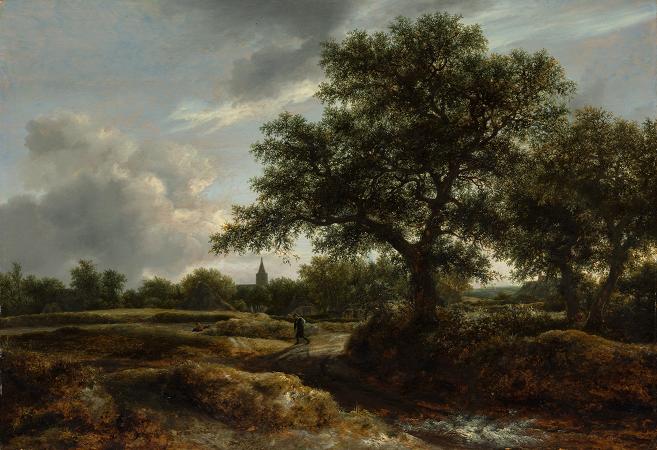Ivan Aivazovsky (1817 - 1900). Ivan Konstantinovich Aivazovsky was a Russian Romantic painter who is considered one of the greatest masters of marine art. Baptized as Hovhannes Aivazian, he was born into an Armenian family in the Black Sea port of Feodosia in Crimea and was mostly based there. Following his education at the Imperial Academy of Arts in Saint Petersburg, Aivazovsky traveled to Europe and lived briefly in Italy in the early 1840s. He then returned to Russia and was appointed the main painter of the Russian Navy. Aivazovsky had close ties with the military and political elite of the Russian Empire and often attended military maneuvers. He was sponsored by the state and was well-regarded during his lifetime. The saying worthy of Aivazovsky's brush, popularized by Anton Chekhov, was used in Russia for describing something lovely. He remains highly popular in Russia in the 21st century. One of the most prominent Russian artists of his time, Aivazovsky was also popular outside Russian Empire. He held numerous solo exhibitions in Europe and the United States. During his almost 60-year career, he created around 6,000 paintings, making him one of the most prolific artists of his time. The vast majority of his works are seascapes, but he often depicted battle scenes, Armenian themes, and portraiture. Most of Aivazovsky's works are kept in Russian, Ukrainian and Armenian museums as well as private collections. Ivan Aivazovsky was born on 17 July 1817 in the city of Feodosia, Crimea, Russian Empire. In the baptismal records of the local St. Sargis Armenian Apostolic Church, Aivazovsky was listed as Hovhannes, son of Gevorg Aivazian. During his study at the Imperial Academy of Arts, he was known in Russian as Ivan Gaivazovsky. He signed an 1844 letter with an Italianized rendition of his name: Giovani Aivazovsky. His father, Konstantin, was an Armenian merchant from the Polish region of Galicia. His family had migrated to Europe from Western Armenia in the 18th century. After numerous familial conflicts, Konstantin left Galicia for Moldavia, later moving to Bukovina, before settling in Feodosia in the early 1800s. He was initially known as Gevorg Aivazian, but he changed his last name to Gaivazovsky by adding the Polish -sky. Aivazovsky's mother, Ripsime, was a Feodosia Armenian. The couple had five children, three daughters and two sons. Aivazovsky's elder brother, Gabriel, was a prominent historian and an Armenian Apostolic archbishop. The young Aivazovsky received parochial education at Feodosia's St. Sargis Armenian Church. He was taught drawing by Jacob Koch, a local architect. Aivazovsky moved to Simferopol with Taurida Governor Alexander Kaznacheyev's family in 1830 and attended the city's Russian gymnasium. In 1833, Aivazovsky arrived in the Russian capital, Saint Petersburg, to study at the Imperial Academy of Arts in Maxim Vorobiev's landscape class. In 1835, he was awarded with a silver medal and appointed assistant to the French painter Philippe Tanneur. In September 1836, Aivazovsky met Russia's national poet Alexander Pushkin during the latter's visit to the Academy. In 1837, Aivazovsky joined the battle-painting class of Alexander Sauerweid and participated in Baltic Fleet exercises in the Gulf of Finland. In October 1837, he graduated from the Imperial Academy of Arts with a gold medal, two years earlier than intended. Aivazovsky returned to Feodosia in 1838 and spent two years in his native Crimea. In 1839, he took part in military exercises in the shores of Crimea, where he met Russian admirals Mikhail Lazarev, Pavel Nakhimov and Vladimir Kornilov. In 1840, Aivazovsky was sent by the Imperial Academy of Arts to study in Europe. He first traveled to Venice via Berlin and Vienna and visited San Lazzaro degli Armeni, where an important Armenian Catholic congregation was located and his brother Gabriel lived at the time. Aivazovsky studied Armenian manuscripts and became familiar with Armenian art. He met Russian novelist Nikolai Gogol in Venice. He then headed to Florence, Amalfi and Sorrento. In Florence, he met painter Alexander Ivanov. He remained in Naples and Rome between 1840 and 1842. Aivazovsky was heavily influenced by Italian art and their museums became the second academy for him. According to Rogachevsky the news of successful exhibitions in Italy reached Russia. Pope Gregory XVI awarded him with a golden medal.
more...













